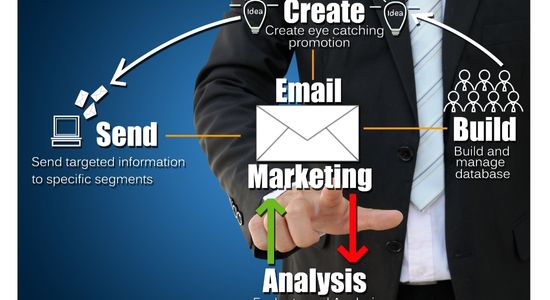Email marketing is a superb way to reach your customers wherever they are without spending a lot of money. But it’s a big responsibility, too—people don’t give their email addresses to just anyone. Are you thinking about starting a company newsletter? Here are 15 tips to keep in mind.
1. Email marketing: Make it easy to subscribe.
Create a signup form and place it on your homepage, blog, Facebook page, and anywhere else your customers and fans are already active. You can collect names and birthdays (for a special offer or gift) or invite readers to join groups, but keep the required fields to a minimum. A too-long subscription form might scare people off.
2. Inform subscribers what to expect.
Whether you plan to send company updates, e-commerce sales, daily deals, or weekly tips, it’s important to inform your readers what to expect and how often to expect it. Give them as much information as possible on your signup form so that they can decide whether or not to join the list.
3. Email marketing: Send a welcome email.
It’s always a good idea to remind people why they’re on your list and reassure them that good things are in the store. You could even send a special offer or exclusive content to new subscribers as a way of thanking them for their loyalty.

4. Design your newsletter to fit your brand.
Your email campaigns should match the look and feel of your brand. For instance, if you’re using a template, you can customize it to include your company’s colors and logo in the header. If your emails are consistent with the rest of your company’s content, readers will feel more at ease.
5. Email marketing: Make it scannable.
Since your subscribers are busy people who get a lot of emails, it’s safe to assume you don’t have their full attention. Instead of one long block, break up your content into short paragraphs. Add subheadings and images to help readers navigate your email and make it easier to scan, and include a teaser at the top of your newsletter to let subscribers know what’s coming up.
If you’re sending a lengthy article, consider including a “read more” link so readers can get to the rest when it’s convenient for them. Your subject line should be to-the-point and easy to digest, too. Consider running an a/b test to see which subject lines perform the best.
6. Email marketing: Send people the content they want.
Email newsletter services offer features like segmentation and groups to help make your content relevant to those who read it. If you’re sending different emails to different groups (for example, a nonprofit might send separate emails to the board of directors, donors, and volunteers), you can ask people to check a box on your signup form in order to join a specific group.
You can target specific subscribers on your list using segmentation without assigning them to a group. If your store is having a sale, you could send a campaign only to people in a particular zip code because subscribers in other parts of the world don’t need to know about it. You can also segment by activity, email clients, e-commerce data, etc. Sending relevant content keeps your readers engaged, and engaged readers look forward to your newsletter and share it with others.
7. Email marketing: Keep a publishing calendar.
A regular newsletter requires commitment. If you don’t send anything for several months, your subscribers will forget about you and are more likely to delete the next email or, worse, mark it as spam. Make time to plan, write, design, and distribute your newsletters on a regular basis.

8. Edit.
Even editors need editors. When you’re working on your publishing calendar, leave plenty of time for editing and revision. Once you send a campaign, it goes straight to the inbox, and you can’t go back and change anything. Newsletters should be informative, and sloppy ones reflect poorly on the companies that send them. Grammar and style are just as important for email as they are for websites and blogs.
9. Test.
Different mobile devices display emails differently. Therefore, send test emails to colleagues, or use a testing program to ensure your emails look good on both big and small screens. Testing reveals design flaws before it’s too late, and testing programs can indicate whether or not a campaign will be flagged as spam. You could even set up accounts with a few different email services for testing purposes. Avoid sending a single large image as a campaign, and make sure every email has a plain-text option.
10. Email marketing: Think about mobile.
If a campaign isn’t visible on mobile devices, it’s not going to perform very well. Everything you send should be mobile-friendly. According to one study, 41% of Europeans and 63% of Americans would either close or delete an email that’s not optimized for mobile. It may be time to start using a responsive template.
11. Know your spam rules.
Many innocent people send spam because they didn’t know any better. Simply put, you’re allowed to send bulk emails only to people who specifically asked to be on your mailing list. If you collected email addresses for an event invitation or a lunch giveaway, you don’t have permission to send marketing emails unless you clarify this at signup. Include an unsubscribe link in every email, and always remind your subscribers how they got on your list in the first place.
12. Email marketing: Make it shareable.
Send content that people want to share, and make it easy for them to do it. Subscribers can, of course, forward your campaign to friends, but that’s a lot to ask. Instead, you can include a public link to your campaign’s web version so people outside of your email programs can read it. Also, consider adding Twitter and Facebook links to your newsletter, so readers can share your content where they’re already active. You’ll know it’s working when their friends start sharing and subscribing.
13. Keep an eye on your stats.
Most email newsletter services provide free reports that contain helpful information. Learn how to read and understand your reports, so you can use the stats to improve your future campaigns. Keep an eye on your open and click rates, and identify any patterns that make those numbers rise or fall. If a campaign receives a high number of unsubscribes, then try a different approach next time.
14. Email marketing: Be friendly.
Use a friendly tone in your email newsletters. Since most emails come directly from one person, people expect human voices in their inboxes. There’s a good chance your subscribers are already relaxed when checking their email, so an overly formal voice may seem out of place. Also, they’ve given you their email address, so you’re already on a first-name basis. If you collect first names on your signup form, you can include them in your email greetings.
15. Only send emails if you have something to say.
This may seem obvious, but too many companies start email newsletters without a plan. Email is simply a way to publish content—the content itself has to come first. Before starting a newsletter, make sure it’s a long-term commitment that will help you achieve your business goals. Otherwise, you’ll be wasting your subscribers’ time and your own time. Therefore, ask yourself what you have to say and send thoughtful newsletters, keeping the focus on your company’s message.
Hopefully, these email marketing tips will help you build a better relationship with your audience. Do share your thoughts on these tips in the comments below.

